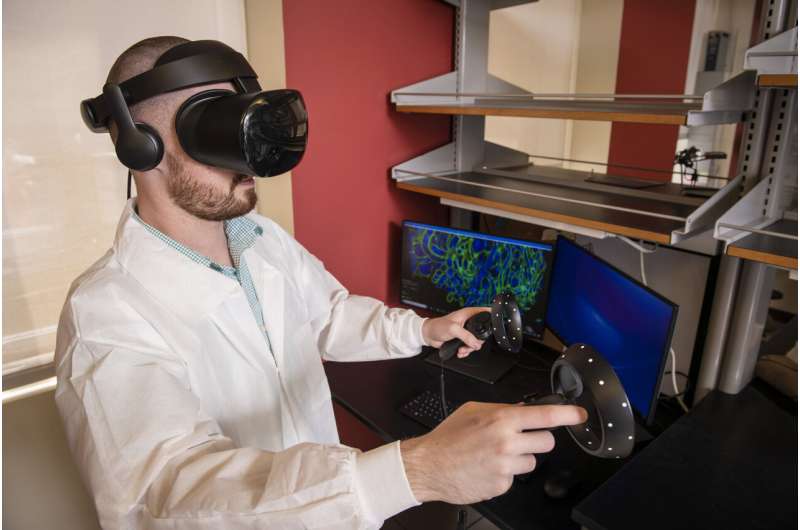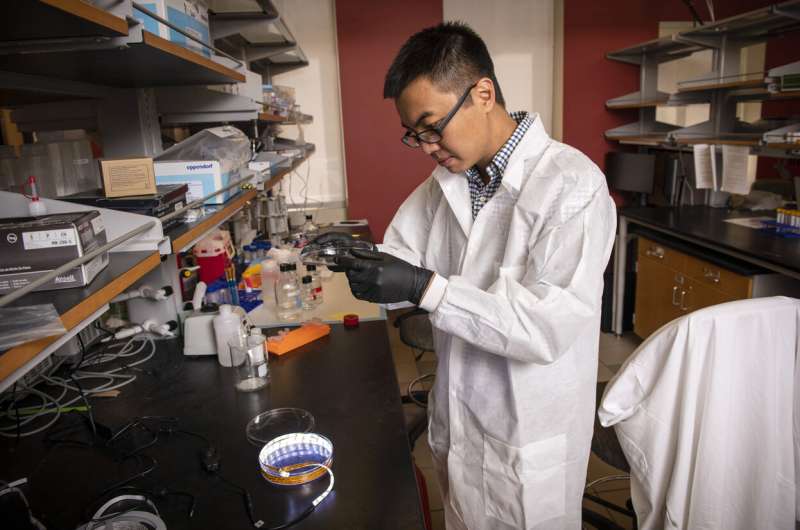Expansion microscopy and virtual reality illuminate new ways to prevent and treat disease

A combined research team from Carnegie Mellon University and Benaroya Research Institute at Virginia Mason is pairing a nanoscale imaging technique with virtual reality (VR) technology to create a method that allows researchers to "step inside" their biological data.
By combining the technique, called expansion microscopy, with VR, scientists will be able to enlarge, explore and analyze cell structures far beyond the capabilities of traditional light microscopy.
The development of these technologies, a two-step process funded at $200,000 through Grand Challenges, an initiative of the Bill & Melinda Gates Foundation, will accelerate researchers' understanding of infectious and autoimmune diseases and enhance their ability to develop disease diagnostics and prevention and treatment methods.
Yongxin (Leon) Zhao, an assistant professor of biological sciences at Carnegie Mellon's Mellon College of Science, has been developing the expansion microscopy technique to physically magnify a biopsy, allowing researchers to see fine details in biological samples using standard microscopes.
Zhao makes biopsy samples grow in size by chemically transforming them into water-soluble hydrogels. He then applies a treatment that loosens the tissues and allows them to expand more than 100 times in volume. The tissues and molecules within the sample can then be labeled, imaged and compiled into a complex set of data, to be used to study interactions among cells and their structures.
However, a limitation of the technology is that it extracts two to three orders of magnitudes more data than current techniques are able to interpret. To help solve that problem, the Gates Foundation grant pairs expansion microscopy with a virtual reality technique developed at the Benaroya Research Institute at Virginia Mason (BRI).
Through VR technology developed specifically for this purpose, researchers will be able to see and manipulate the originally 2-D expansion microscopy images in 3-D, giving them a 360 degree view of tissue and protein organizations and interactions.
"At BRI, we'll prepare the live infectious and autoimmune disease samples," said Caroline Stefani, senior postdoctoral research associate. "We'll send those to Carnegie Mellon, where they will enlarge the samples and send images back to BRI to be viewed in VR."
"This is the future of how scientists can handle complex data," Zhao said. "It's an immersive experience, just like you are sitting inside your data. You have the freedom to explore your data from every angle and every spot."

The virtual reality technology was developed by Tom Skillman, BRI's former director of research technology, who has since founded a VR company, Immersive Science.
"My role in this grant is to develop a software tool that will allow scientists studying disease a way to understand large amounts of data through a computational technique called 'immersive science,'" Skillman said. "Bringing all that data into VR not only allows the scientist to see their 2-D microscope images in full 3-D, but to interact with the data, selecting channels, adjusting the views, colors and contrast, and grabbing and rotating the images to quickly identify key aspects of the image that are coupled back to the disease under study."
The eventual goal is for the VR tool, called ExMicroVR, to be shared on open platforms with other researchers along with expansion microscopy so that they too can view new details of disease processes and understand larger, more complex sets of data.
The system to convert expansion microscopy data into VR 3-D images will be affordable and easily accessible to researchers and physicians in developing countries. It will also allow for up to six people to collaborate and view the same sample remotely at the same time.
Provided by Carnegie Mellon University




















